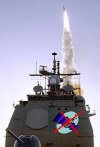I'm sorry, but
I fail to see how hitting two similarly sized ballistic targets is more difficult simply because one is an ICBM. I think the most difficult part of getting an ICBM would be ensuring that the launch platform is in the proper place for an intercept.
Given an excellent radar combined with a capable missile, I think the chances are in our favor.
Note: If I were the CO of the LE I'd definitely be putting a satalite on my bridge wing

You need to expand your thinking a little bit.......An ICBM comes in a much higher altitude and much faster than a SRBM and a MRBM and can cover a much wider area in terms of targets. Also, an ICBM would be launched from a much further distance away (around 10,000 miles) than an SRBM/MRBM (300-1500 miles) and getting a targeting solution is many times more complex. A very rough analogy would be using a ZSU-23 against a helo flying at 200ft and 100kts vs a ZSU-23 against a F/A-18 at 10,00ft and 600kts. They are both aircraft that can be hit by the ZSU-23, but drastically different targets.
If you just look at the basics, the launch site or platform would probably be launching their interceptor blind to make a successful intercept because of the great distances invloved, cued from an off-site sensor, giving them mere seconds to react an launch on what may or may not be an ICBM. With a lot of SRBM's and MRBM's, the launchers might be cued from off site sensors but they would still be able to get their own targeting solutions before firing. It is also great when you know from where and when something is coming, like a satellite, but you are probably not going to know that when it comes to a surprise ICBM attack, with multiple targets (MIRV's) inbound. The SM-3 was not designed for that type of scenario, that is what the Ground Based Interceptors (GBI's) in Alaska and California are supposed to take care of, and which have not had the very good testing history of the SM-3's.
I have dealt quite a bit with this issue in the recent past and I still keep very up to date with it. Missile defense is an incredibly complex problem that has many more moving parts, and a
much more complex target set, than people realize. Some of the work that has been done has been very good, like the SM-3 and the PAC-3, but that does not make the massive investment in some of the MDA work (the SM-3, PAC-3 and THAAD only take up so much of the MDA budget) on the bigger problem of ICBM's is tilting at windmills. It is not an impossible problem to solve, but I don't think it is worth the investment necessary for the limited number of targets.










